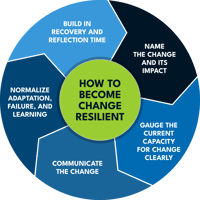Want High-Performing Teams? It's Time To Start Leveraging Competency Frameworks

In today's fast-paced business world, organizational leaders must ensure that their team(s) are equipped with the necessary tools and guidance to succeed. Most leaders when they think of tools they need to provide to support their teams, think of software they can provide (e.g. CRM, HRIS, Gong); equipment (e.g. computers, noise-canceling headphones, standing desks); and collaboration software (e.g. Slack, Teams, Zoom). Sadly, too many organizations underutilize a powerful tool that when leveraged effectively gives the required guidance to succeed - a clear and comprehensive competency framework that articulates the expectations for every role.
What exactly are competencies? Why are they so vital for defining role expectations? I'm so glad you asked! This blog post covers
- What competencies are (and aren't)
- The importance of competencies
- The potential consequences of not having well-articulated competencies
- The high-level process to create a robust competency framework.
What Are Competencies?
Competencies are the observable and measurable knowledge, skills, and behaviors required to be successful in a role. Often confused with competence, which refers to what a person knows about a specific subject, competencies define the expected "how" of achieving job performance. For example, a person achieves competence in delivering feedback by gaining competencies in active listening, managing difficult conversations, and asking questions. What makes competencies so difficult for most leaders to pinpoint let alone leverage as a support tool with their team, is that they are the sum of 3 key criteria:
- Knowledge: This refers to the understanding, awareness, or familiarity gained through education, experience, or study. It encompasses the facts, information, and theoretical concepts that an individual has acquired over time. Example: Understanding the principles of accounting, knowing the rules of grammar, or having awareness of historical events.
- Skill: The ability to perform tasks or activities proficiently through practice, training, or experience. Skills can be either technical (hard skills) or interpersonal (soft skills). Example: Proficiency in using a software program, ability to perform complex mathematical calculations, or effective communication and negotiation skills.
- Behaviors: Observable actions; how one acts or conducts oneself in response to external or internal stimuli, often influenced by knowledge, skills, and attitudes. Example: Demonstrating altruism at work, participating cooperatively in a team project, or acting aggressively in response to feedback
Why Are Competencies Important?
Competencies are crucial for several reasons, first and foremost, they help in defining role expectations by setting specific standards for each position within an organization, providing a clear roadmap for what success looks like. By setting clear standards, managers, trained in delivering feedback and holding performance management conversations can leverage the language in the competencies to provide feedback based on objective criteria, that assess how well employees are meeting their role expectations When performance management conversations are objective, consistent, and development focused, team members are able to turn that feedback into course corrective next steps. Lastly, competencies support long-term career development by highlighting the skills and behaviors needed for advancement, helping employees plan and progress their careers more effectively.
Consequences of Not Having Well-Articulated Competencies
It's not enough to consider the benefits of implementing a competency framework, it's critical to consider what happens when organizations don't define competencies. Without clearly defined competencies, organizations may face several issues. First and foremost, employees may experience ambiguity in expectations, leading to inconsistent performance and confusion about their roles. This lack of clarity can result in ineffective performance evaluations, where the absence of objective criteria leads to biased and subjective assessments, causing favoritism, over/under-rewarding, dissatisfaction and disengagement. Additionally, gaps in training and development can emerge, as it becomes challenging to identify and address skill deficiencies, resulting in inadequate employee growth. Finally, career progression may stall, as employees struggle to understand what is required for advancement, leading to frustration and increased turnover.
Key Ingredients For Quality Competency Frameworks
To develop a robust competency framework, organizations need to spend time mapping each of these key areas:- Roles and Responsibilities: Clearly define all the roles within the organization and their primary responsibilities so that you know what strategic business goals the competencies are supporting.
- Competency Descriptions: For each role, identify the knowledge, skills, attitudes, and behaviors necessary for success. Write detailed descriptions for each competency, including specific examples of behaviors that demonstrate each competency level. Poorly defined competencies are those that focus on ambiguously defined outcomes; they run the risk of differing interpretations of success. When this happens, expectations vary between managers and team members, and frustrations arise. When competencies are clearly defined and based on observable and measurable behaviors they articulate to everyone exactly what great performance of the competency looks like.
- Competency Levels: Establish the levels of expected proficiency for each competency, such as foundational, intermediate, advanced, and expert. This helps in assessing and developing competencies progressively.
- Competency Cluster: A grouping of competencies that are related to one another, contributing to success in a key domain (e.g. Building Collaborative Relationships).
- Stakeholders: Engage managers, employees, and other key stakeholders in the process, to ensure all competencies are relevant, comprehensive, and bought into.
- Implementation and Communication: How you plan to roll out the competency framework across the organization, including emails, office hours, training(s), and resources to help leaders and employees understand and utilize them.
- Monitor and Iteration: Regularly review and update the competency framework(s) to ensure they continue to be aligned with organizational goals and industry standards.
By including all these key ingredients in competency frameworks, organizations can create quality competency frameworks that define clear expectations, support performance management, and foster employee development and career growth.

Conclusion
Competencies are foundational to defining role expectations and driving organizational success. They provide clarity, consistency, and direction for employees, enabling them to perform effectively and grow within the company. By understanding the importance of competencies and implementing a robust competency framework, leaders can ensure their teams are well-equipped to meet the demands of today's dynamic business environment. Look to chat out your thoughts as you embark on a competency mapping project?




